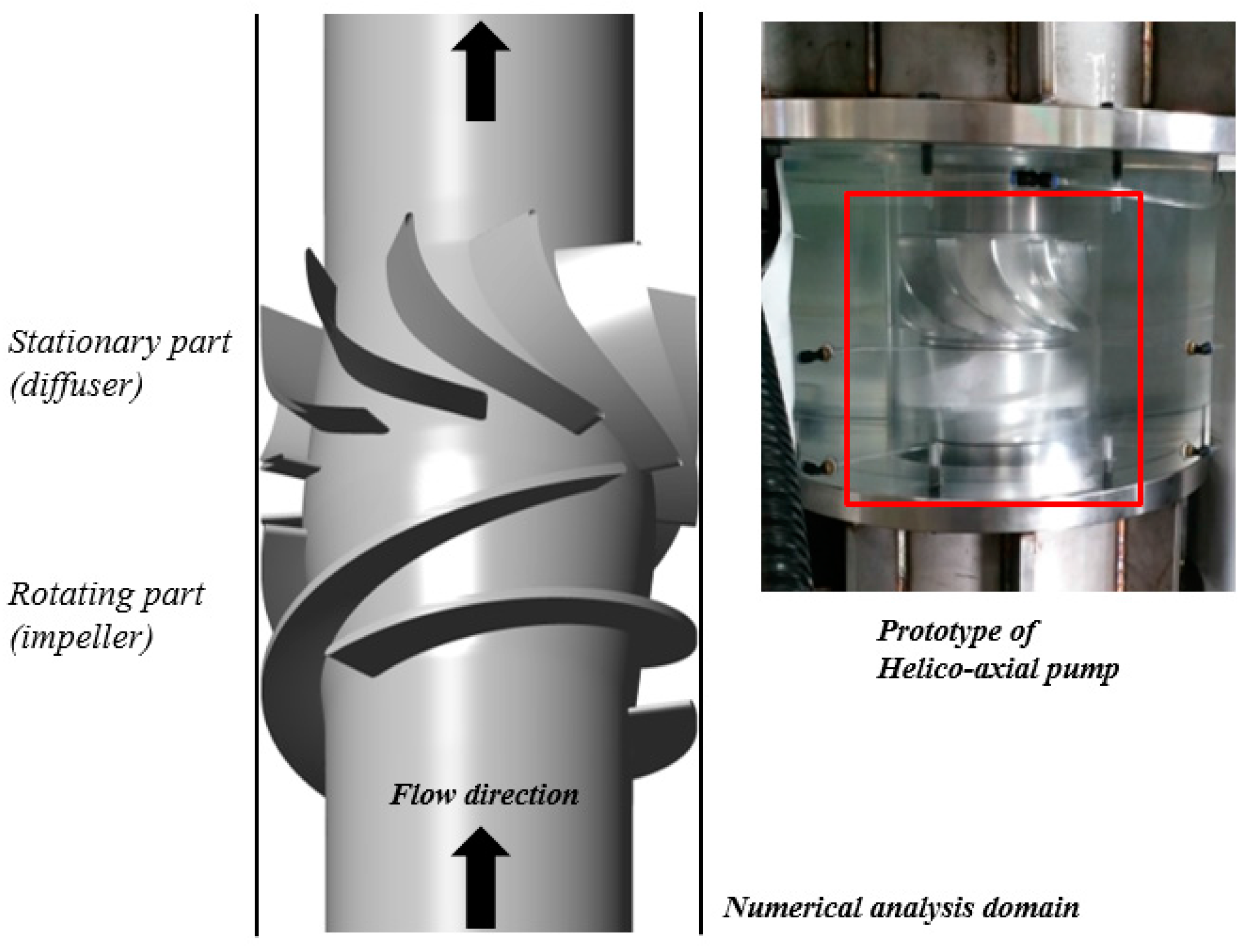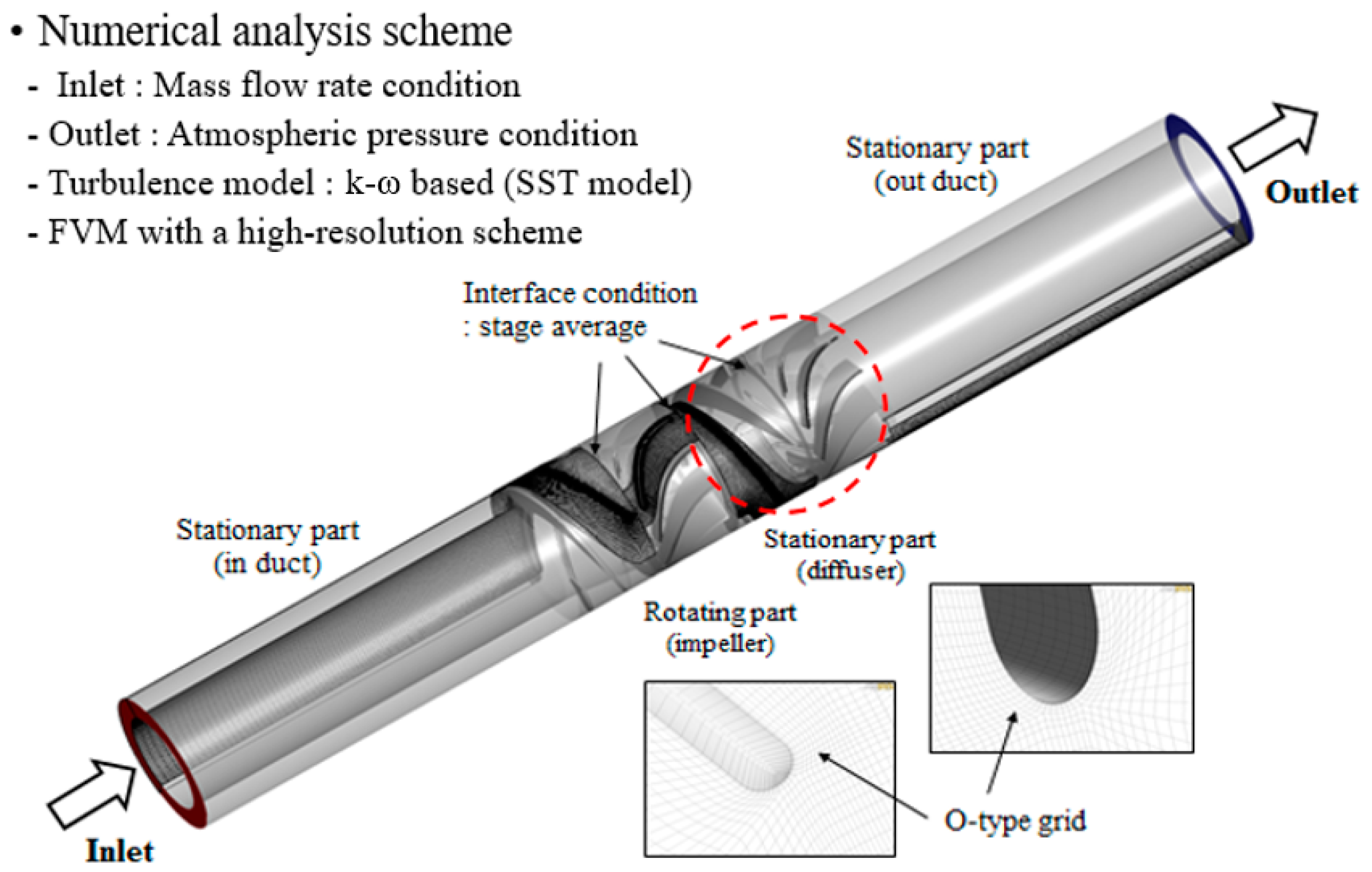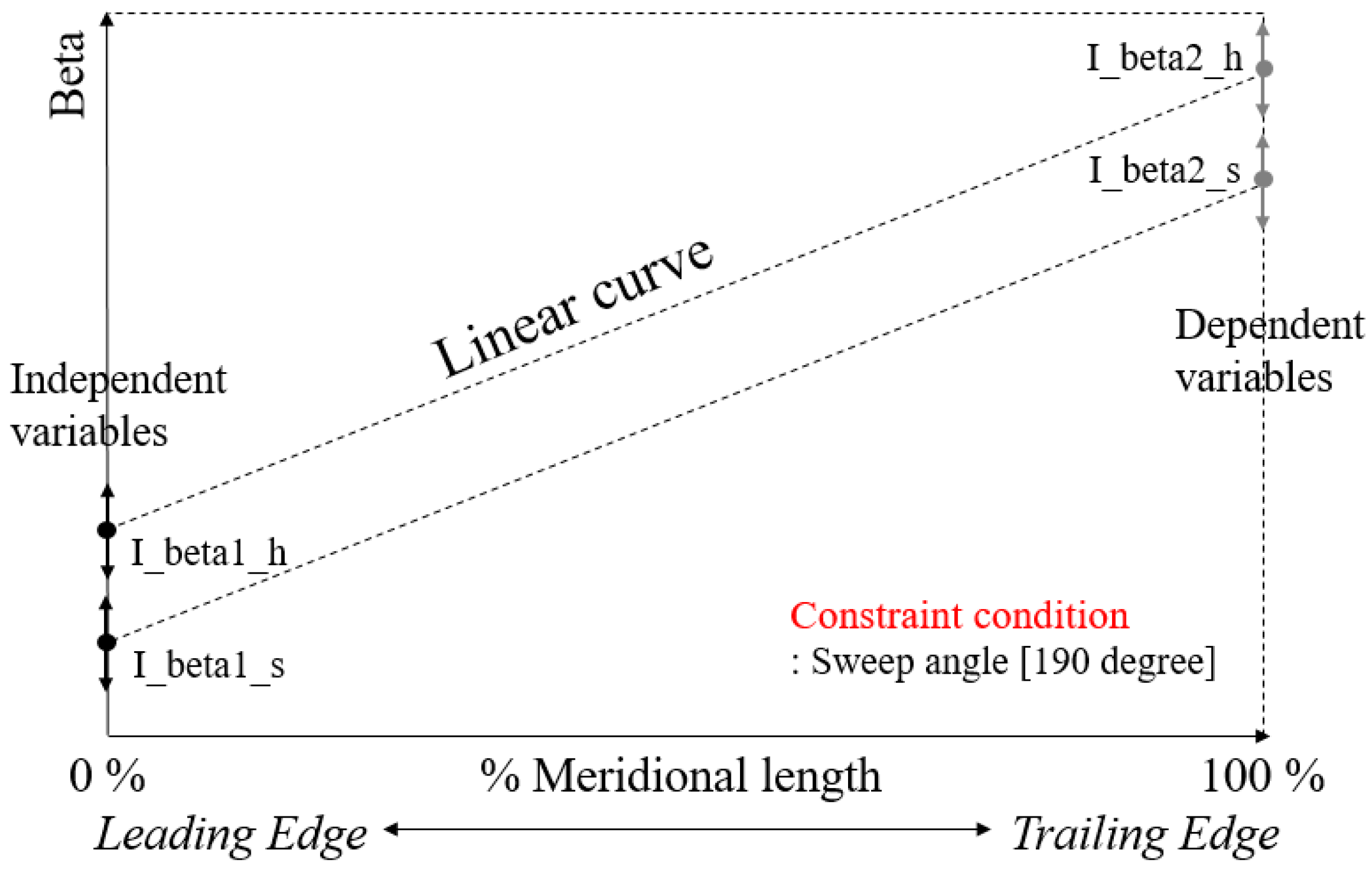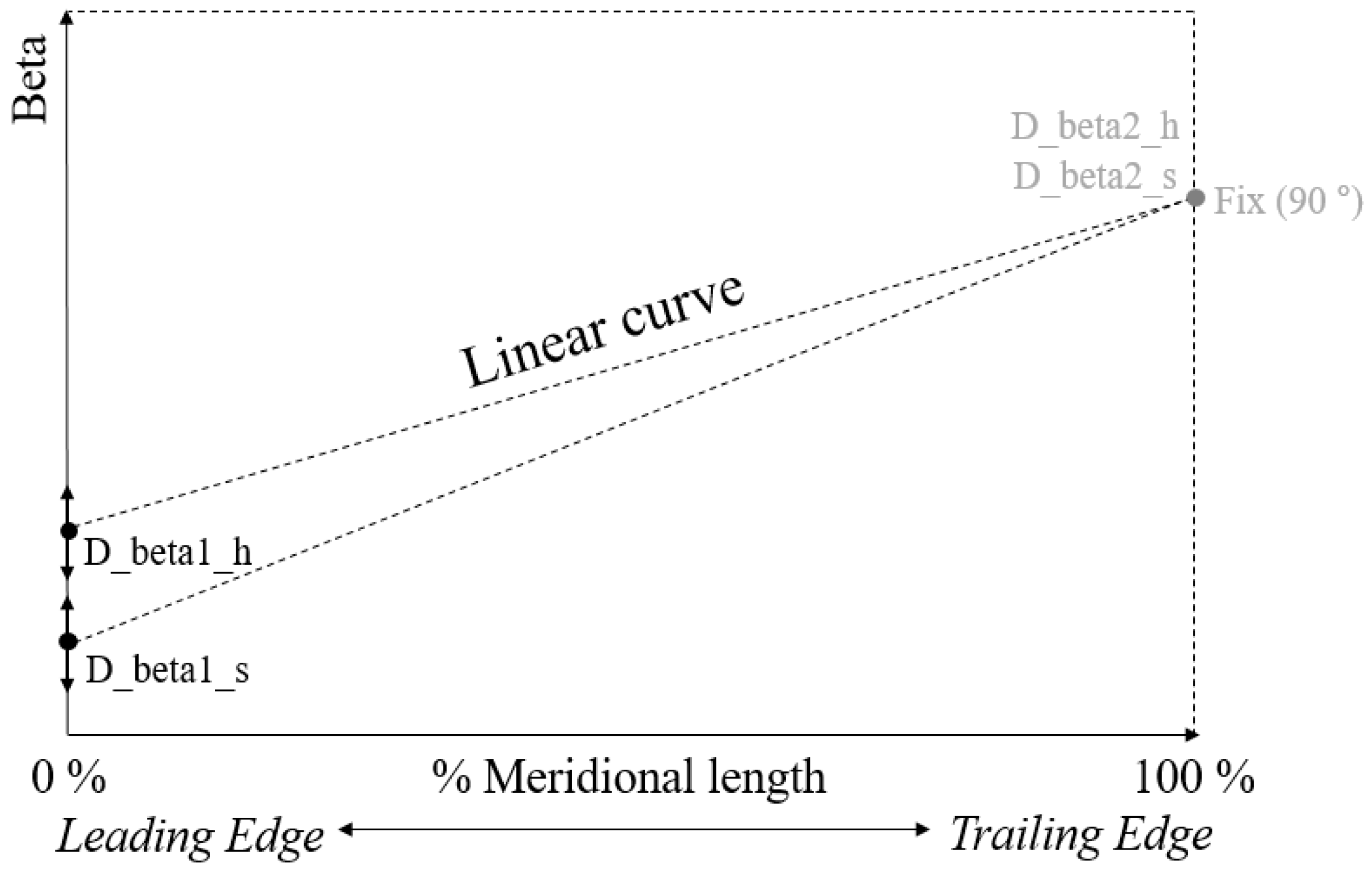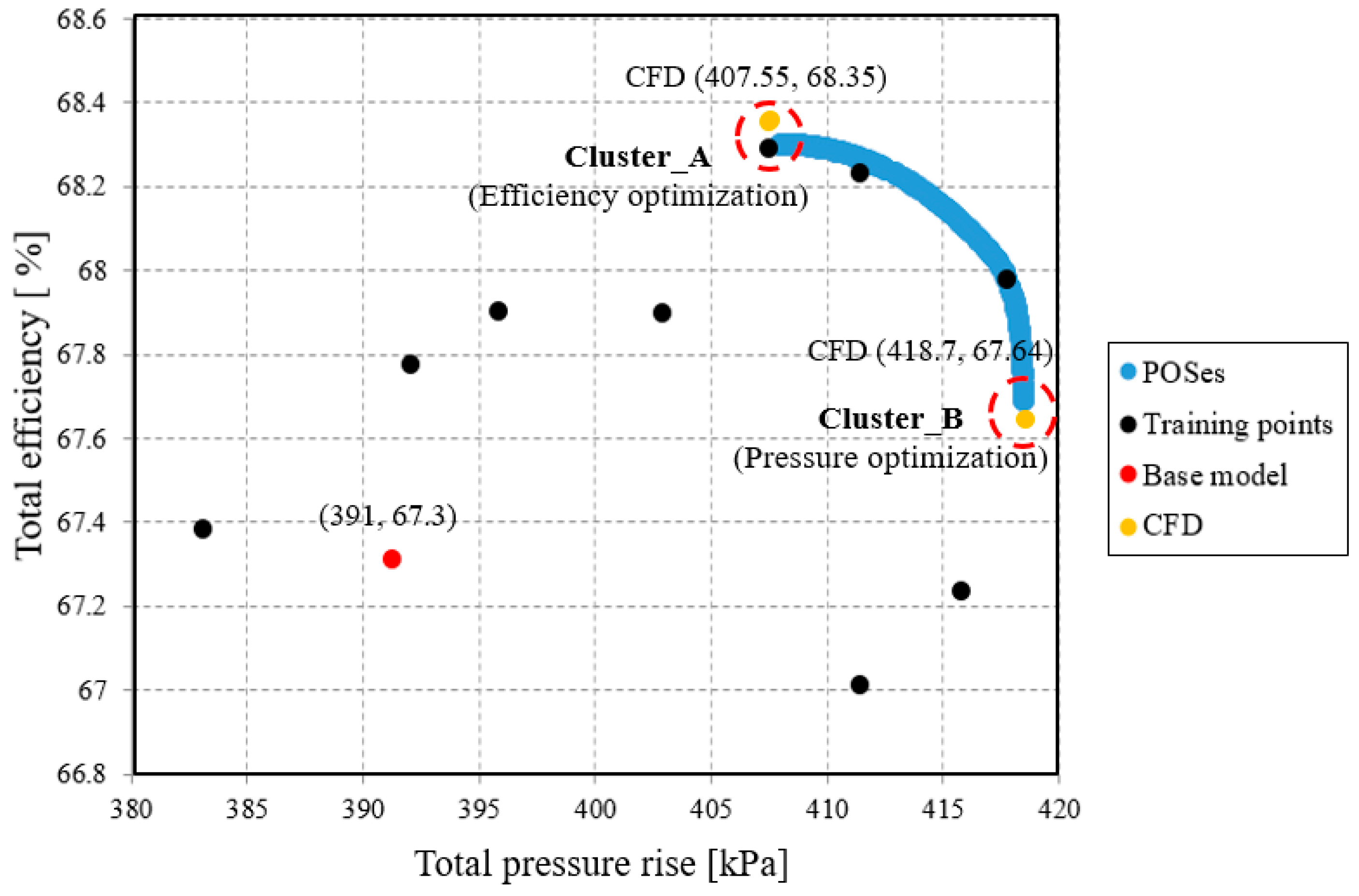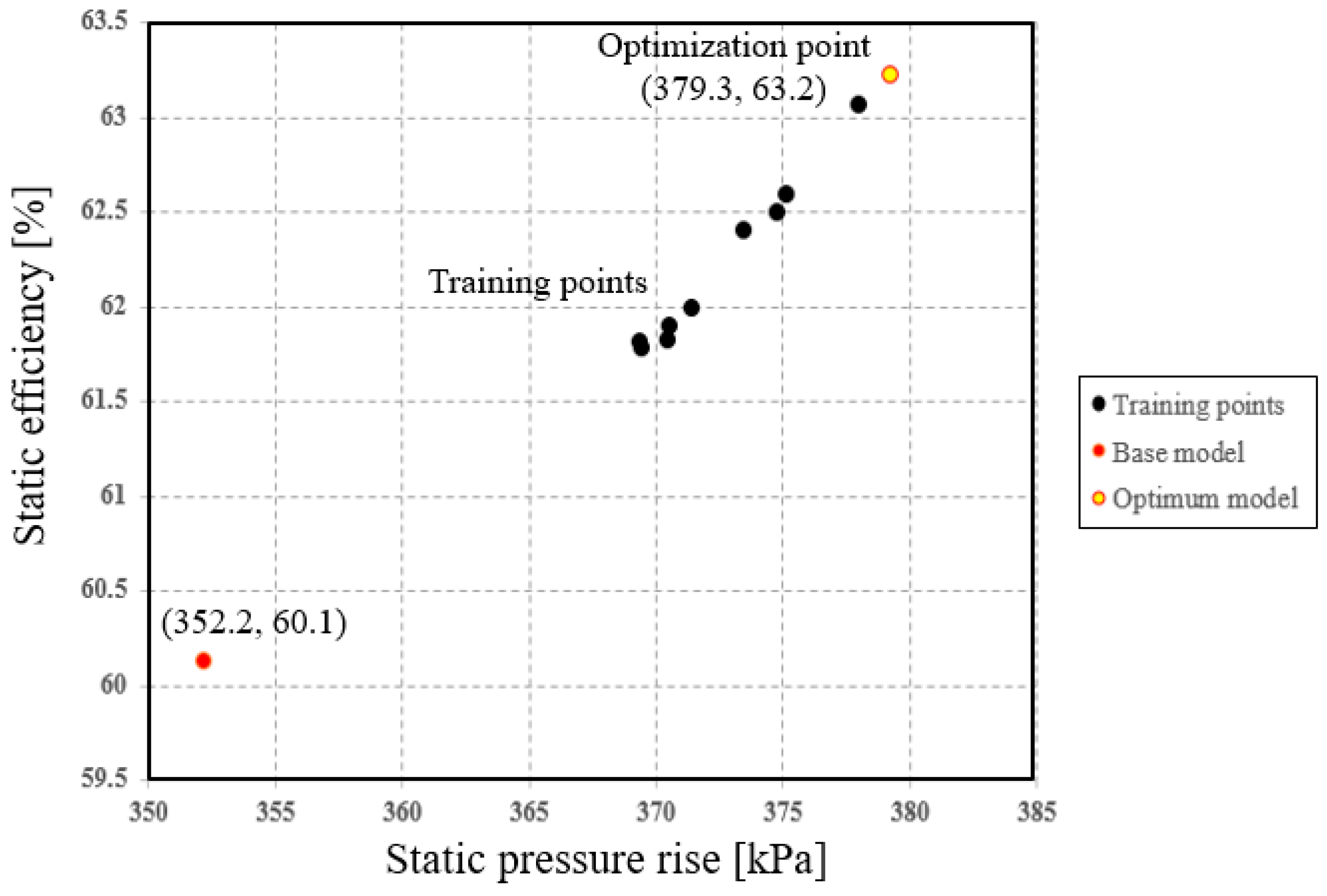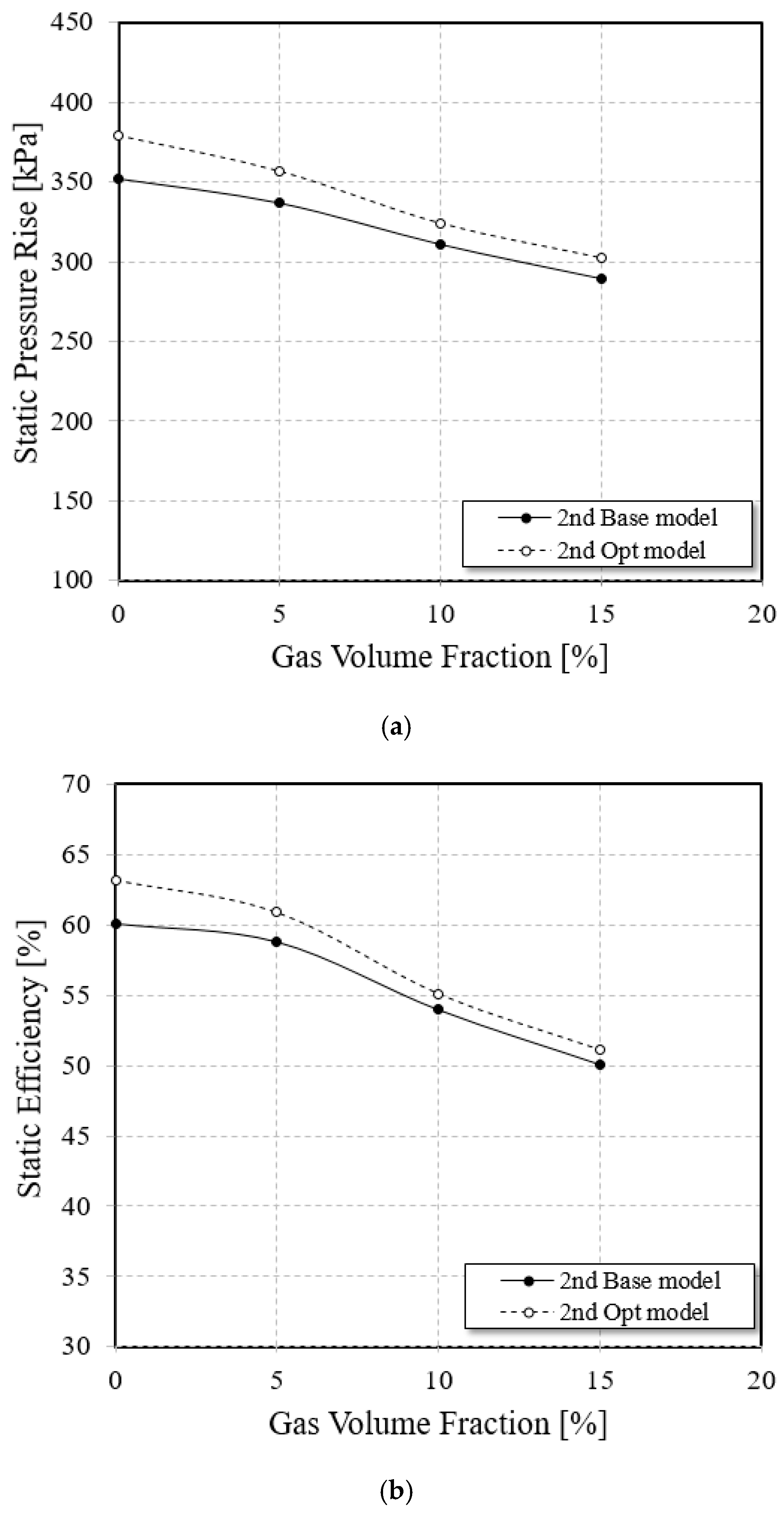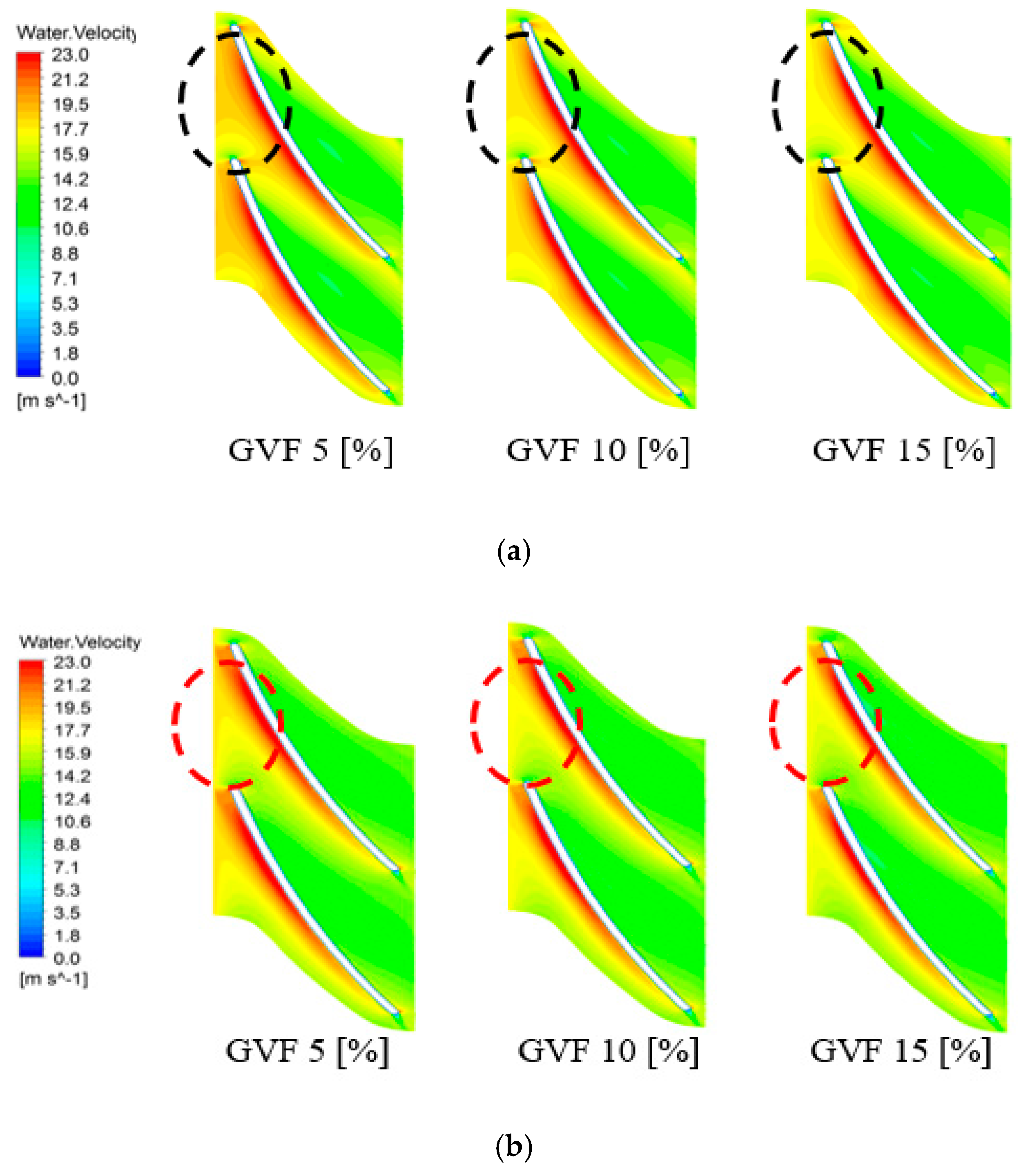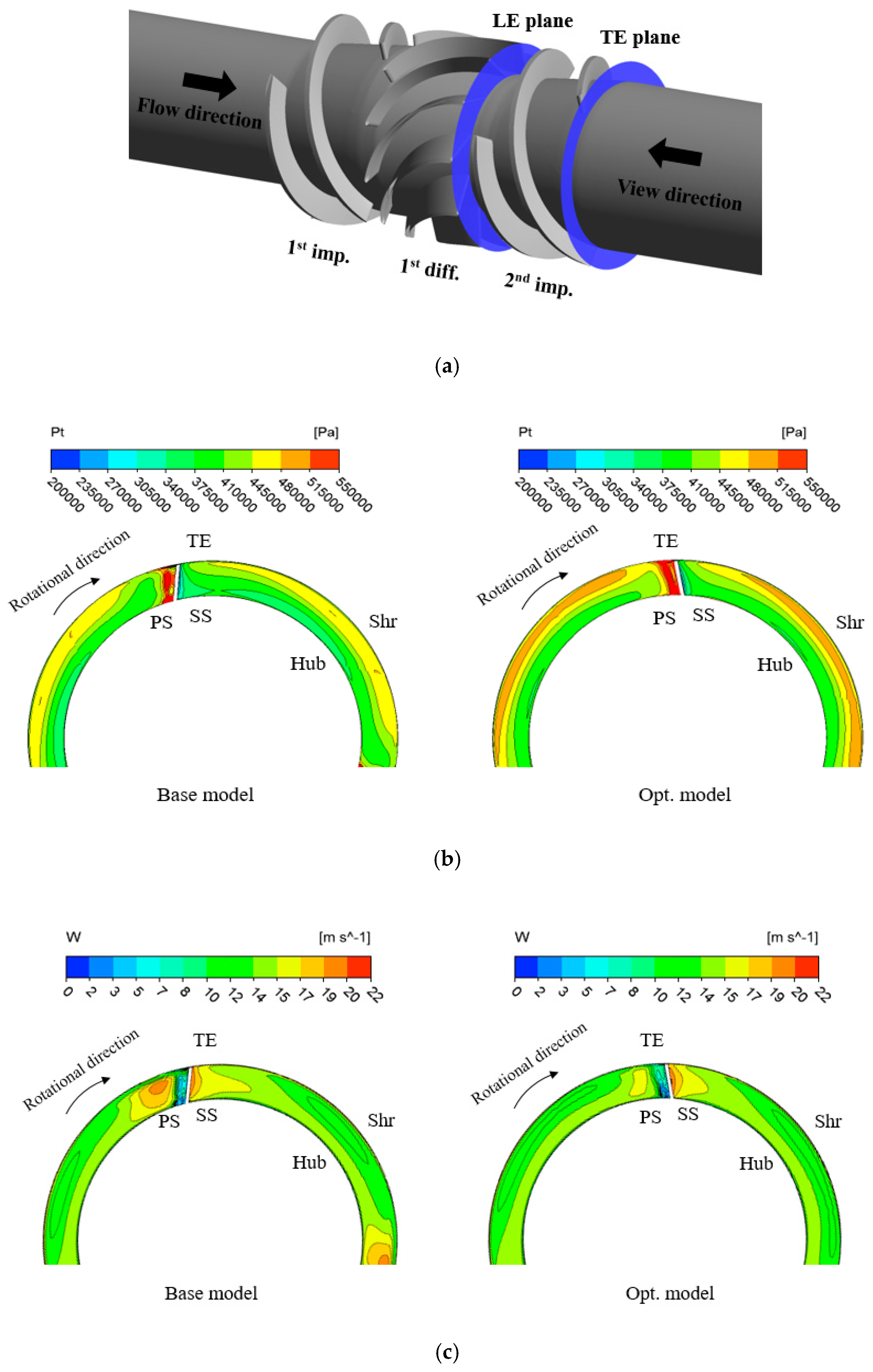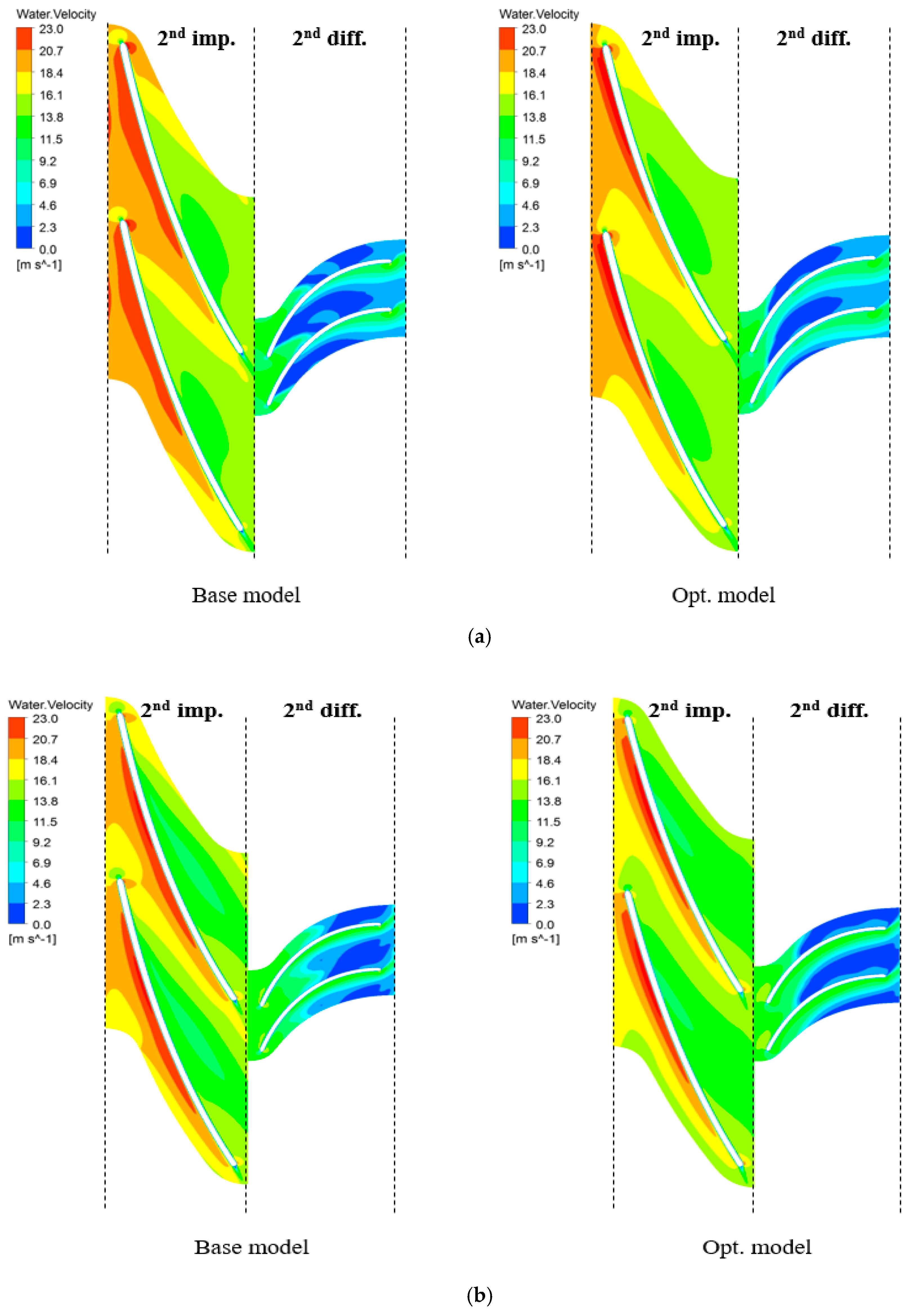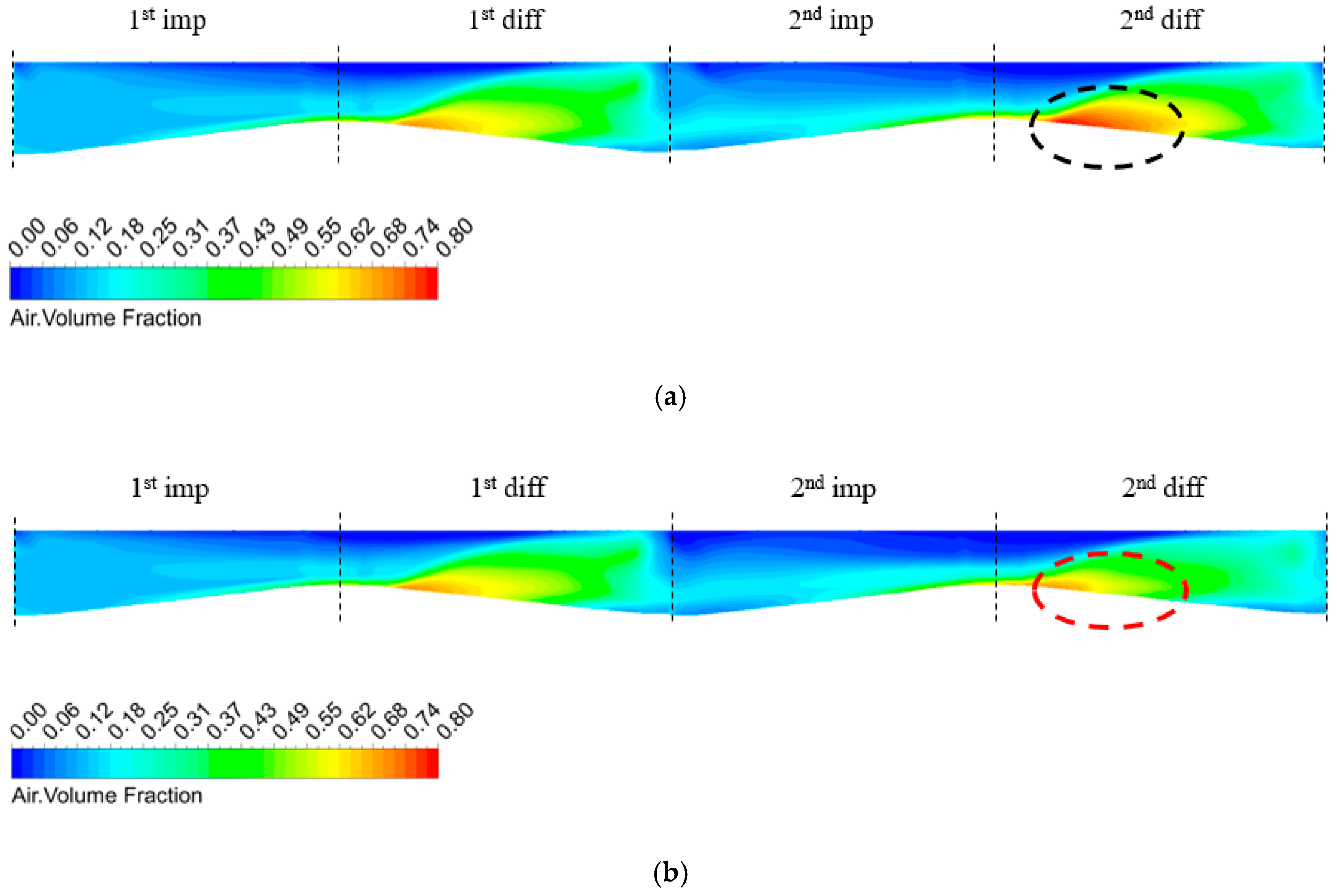Results of Multi-Objective Optimization
The multi-objective optimizations of the second impeller and the second diffuser were performed sequentially. Based on the results of a numerical analysis of the test sets generated through CCD, regression analyses of the RSA surrogate model were conducted and multi-objective optimization was performed to obtain the global POSs, as shown in
Figure 7. The results of the regression analysis of the response surface, including the root mean-square error (RMSE) of the multi-objective function, were analyzed by the RSA. For acceptable accuracy, the value of R
adj2 needed to be in the range 0.9 < R
adj2 < 1.0 [
31]. The values of R
adj2 for total efficiency and total pressure were 0.9912 and 0.9885, respectively. Thus, all predicted values obtained using the RSA models were reliable. The functional forms from the RSA model can be expressed in terms of design variables normalized as follows:
where
and
represent the impeller’s hub inlet angle (
I_beta1hub) and the shroud’s inlet angle (
I_beta1shr), respectively.
A trade-off analysis shows an obvious correlation between total efficiency and total pressure. In other words, the improvement in total efficiency led to a deterioration in total pressure performance, and vice versa. Designers will use one or several solutions from POSs as the optimum solution(s) to solve multi-objective optimization problems.
Cluster_A shows an efficiency optimization model and
Cluster_B a pressure optimization model. Two arbitrarily clustered optimum models, oriented for each objective function, were selected in the POSs and calculated through CFD analysis. Their results are in agreement with the predicted values generated by the POSs, and both points presented visibly increased hydraulic performance compared with the base model.
Cluster_A showed an increase of 1.1% in total efficiency and that of 16.3 kPa in total pressure, and
Cluster_B showed an increase of 0.34% in total efficiency and 27.7 kPa in total pressure.
Cluster_A, which was near the end of the global POSs, was selected as the final model of the second-stage impeller. Since the impeller and the diffuser in the first stage had been optimized to improve hydraulic efficiency, this study focused on efficiency-oriented design to maximize stage performance [
10]. The results of the multi-objective optimization of the second impeller are shown in
Table 4.
The independent design variables of the inlet blade angle at the hub were reduced by 0.5 degrees, and the inlet blade angle at the shroud increased by 3.5 degrees. This indicates that the impeller’s shroud angle at the inlet (I_beta1shr) was much more sensitive than the diffuser’s hub angle at the inlet (I_beta1hub). Moreover, the dependent design variables of the outlet blade angle at the hub and the shroud increased by 4.0 degrees and 2.5 degrees, respectively.
Figure 8 shows the optimal angle distribution of the second-stage impeller. When the inlet blade angle at the hub increased, the performance oriented the pressure optimization. On the other hand, when the inlet blade angle at the shroud increased, the performance oriented the pressure optimization. In accordance with the constraints, in case of the inlet and the outlet angles, the tendency was inversely proportional. For example, as the inlet blade angle at the hub increased, efficiency increased and pressure decreased. The outlet hub angle, on the contrary, showed a tendency whereby efficiency decreased and pressure increased.
Results for the analysis of the response surface of multi-objective optimization to find the optimal point for the hydraulic performance of the diffuser are shown in
Figure 9. The values of R
2 and R
2adj, the explanatory power of the regression model, were 0.9863 and 0.9765, respectively. For the multi-objective optimization of the second diffuser, the multiple linear regression equation can be expressed for static efficiency and pressure as follows:
where
and
represent the diffuser’s hub inlet angle (
D_beta1hub) and the shroud’s inlet angle (
D_beta1shr), respectively.
In the case of the diffuser, there was no trade-off characteristic due to an obvious correlation between static efficiency and static pressure. The predicted performance in terms of static pressure and efficiency were 379.61 kPa and 63.25%, respectively, using the surrogate model and sequential quadratic programming. They were calculated at 379.3 kPa and 63.22%, respectively. The static efficiency of the optimum diffuser hence increased by 3.1% and the static pressure by 27 kPa compared with the base model in single-phase flow. The results of the multi-objective optimization of the second diffuser are shown in
Table 5. Independent design variables of the inlet blade angle at the hub decreased by 0.5 degrees, and the inlet blade angle at the shroud increased by 8.0 degrees. Both the inlet angles at the hub and the shroud showed a similar sensitivity to the objective function.
A comparison of hydraulic performance between the base and the optimum models in terms of the design flow rate was calculated along the GVF ranges as shown in
Figure 10. As the increase in the size and number of bubbles caused them to be more closely spaced, it affected the internal pressure with increasing GVF. When the GVF was 0%, 5%, 10%, and 15%, the static efficiencies of the optimum model were 63.22%, 60.91%, 55.09%, and 51.10%, respectively, and the static pressure increases of the optimum model were calculated as 379.3 kPa, 357 kPa, 324 kPa, and 302 kPa, respectively.
The increase in static pressure and the static efficiency of the optimum model generally increased along the GVF, up to 15% compared with the base model, as shown in
Table 6.
Distributions of static pressure at 50% that span along the streamwise location are shown in
Figure 11. These results indicated that the overall static pressure distribution of the optimum model generally improved compared with that of the base model from the inlet to the outlet. It was confirmed that a higher pressure increase was achieved in the second impeller. Downstream of the impeller, deceleration in flow movement and pressure recovery were observed in the second diffuser.
Figure 12 shows the instantaneous velocity contour mid-span with increasing GVF. In the base model, a region of non-uniform flow was remarkable at the impeller’s leading edge because of the discrepancy between flow angle and blade angle. Due to the positive incidence angle on the surface around the impeller, the detached flow was predominant on the suction surface. The unstable fluid flow induced a negative effect on the performance of pressure rise. On the other hand, in the case of the optimum model, these non-uniform flow components were suppressed and the velocity contour was uniform in comparison with the base model.
Figure 13 shows internal flow contours near the trailing edge of the second impeller. The location of observation is shown in
Figure 13a. As shown in
Figure 13b, the optimum model at the impeller outlet showed a high level of increase in relative total pressure. However, non-uniform flow field components existed from the hub to the shroud in the base model. According to the flow stabilization of the upstream region, the total pressure distributions were generally uniform in the optimum impeller. Furthermore, the deviation in flow at the trailing edge was due to the effects of blade loading, which created a pressure difference between the pressure and the suction sides. These non-uniform flow components were suppressed in the optimum model, and internal flow distributions along the spanwise direction were generally uniform—especially near the region of pressure side—as shown in
Figure 13c.
Figure 14 shows the velocity contours on the blade-to-blade passage at 20%, 50%, and 80% spans. In the base model, accelerating flow and a thin boundary layer on the suction side appeared in the impeller passage. Non-uniform flow was maintained along the streamwise direction, and a combination of the relative velocity and the blade’s rotational speed resulted in a high absolute velocity approaching the diffuser. Flow decelerated and the kinetic energy was transformed into internal energy with a resulting rise in static pressure, as the performance of the diffuser is dependent on the development of boundary layers during the deceleration process. In general, the diffuser was likely to separate from the blade under the action of the adverse pressure gradient. On the other hand, the optimum model showed nearly constant flow and relatively nominal boundary layers on the suction side along the spanwise direction. Moreover, the reduction in flow blockage and instability contributed to the improvement in static pressure recovery in comparison with the base model.
The above results might have been obtained because the flow angle and the blade angle matched well at the inlet and the outlet. These results show that total efficiency and pressure increased because of the optimization.
As shown in
Figure 15, the air volume fraction on the meridional plane at GVF was 15%. The intensity of the air content in the flow accumulated first near the hub due to differences in the circumferential velocity and density between the phases of the impeller. The water and airflow exhibited a disordered flow pattern because of interactions between the rotating and the stationary domains, and flow blockage resulted from flow separation in the diffuser. The magnitude of phase separation at the optimum model was suppressed to a greater extent than that at the base model. It is believed that the greater pressure increments from compressive effects and the reduction of flow instability contributed to the improved phase mixing, static pressure recovery, and smooth flow movements.
